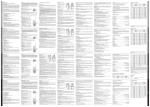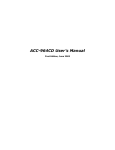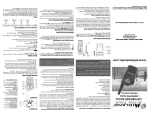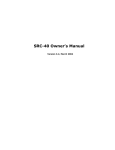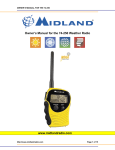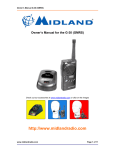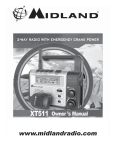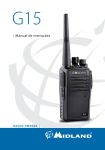Download titan operators manu..
Transcript
This device complies with part 15 of the FCC rules. Operation is subject to the following two conditions: 1. This device may not cause harmful interference, and MON A/D SCAN AUX 2. This device must accept any interference received, including interference that may cause undesired operation. PWR /VOL CH DN MENU UP MON A/D SCAN AUX PWR /VOL CH DN MENU UP TITAN™ FM MULTI-MODE MOBILE RADIO OPERATOR’S MANUAL 1120 CLAY ST • NORTH KANSAS CITY • MISSOURI • 64116 PHONE: (816) 241- 8500 • FAX: (816) 241-5713 www.midlandradio.com 08.2K3 70-2358 FCC RF EXPOSURE REQUIREMENTS The FCC has adopted a safety standard for human exposure to RF energy. Proper operation of this radio under normal conditions results in user exposure to RF energy below the Occupational Safety and Health Act and Federal Communication Commission limits. External Speaker to pins 4 & 6 (required for Deluxe Head) Pin 3 Mic Hang-up Mandatory Safety Instructions to Installers and Users: This radio is NOT approved for use by the general population in an uncontrolled environment. This radio is restricted to occupational use and work related operations only. Radio operators must have the knowledge to control their exposure conditions and the exposure conditions of bystanders and/or passengers to satisfy the lower exposure limit allowed for General Population. To comply with FCC RF exposure limits, DO NOT operate the transmitter of this mobile radio when a person outside the vehicle is within 94 centimeters (38 inches) of the antenna. The antenna supplied by the manufacturer or radio dealer must be mounted at a location such that during radio transmission, no person or persons can come closer than the above indicated minimum safe distance to the antenna, i.e. 94cm. To comply with current FCC RF exposure limits, the antenna must be installed at or exceeding the minimum safe distance stated above, and in accordance with the requirements of the antenna manufacturer or supplier. 6 7 8 9 10 1 2 3 4 5 Brown jumper wire between pins 5 & 6 (internal speaker only) Brown jumper wire between pins 5 & 6 (internal speaker only) Vehicle Installation Instructions: The antenna used for this transmitter must be mounted on the center of the roof ONLY and must be installed in vehicle having the following characteristics in order to prevent bystanders and passengers from being exposed to levels exceeding the limits for General Population/Uncontrolled Exposure environment: y All passengers must be sitting under a solid metal roof. y Rooftop width must be at least 76 inches OR the edges of the physical boundary of the vehicle must be at least 76 inches apart. DO NOT operate the radio without the proper antenna installed. Do not substitute any antenna for the one supplied or recommended by the manufacturer or radio dealer. The antenna gain must not exceed 0 dBd. By not following the antenna recommendations you may be exposing person(s) to excess radio frequency radiation. You may contact your radio dealer or the manufacturer for further instructions. i 3 6 9 12 2 5 8 11 1 4 7 10 70-2358 External Speaker to pins 4 & 6 (Required for Deluxe Head) Pin 3 Mic Hang-Up (Pin 2 is GND) 8 SERVICE MANUALS Testing, alignment and service information are provided in the service manual for this model. Service manuals for Titan™ radios are available from Midland Radio Corporation at the address shown on the back cover. DO NOT transmit more than 50% of total radio use time (50% duty cycle). Transmitting for more than 50% of the time can cause FCC RF exposure compliance requirements to be exceeded. This radio is transmitting whenever the TX icon is displayed on the LCD. Pressing the PTT switch on the side of the microphone normally causes the radio to transmit. Note: The preceding information is provided to make you aware of RF exposure and how to ensure that this radio is operated within FCC RF exposure limits. You, as the qualified end-user of this radio device must control the exposure conditions of bystanders to ensure the minimum separation distance, stated above for satisfying FCC RF exposure compliance, is maintained between the antenna and nearby persons. Transmit only when all person(s) are at least the minimum distance from the properly installed, externally mounted antenna. IMPORTANT SAFETY INFORMATION CAUTIONS a The antenna connector must be snugly tightened to maintain proper electrical connection and moisture resistance. a Equipment must be grounded according to Midland Radio Corporation installation instructions for safe operation. a Equipment should be serviced only by a qualified technician. a Refer to radio service manual for additional information on installation and safety precautions. WARNING! ! DO NOT allow the antenna to touch or come in very close proximity with the eyes, face, or any exposed body parts while the radio is transmitting ! DO NOT operate the radio in explosive or flammable atmospheres. The transmitted radio energy could trigger blasting caps or cause an explosion. ! DO NOT allow children to operate or play with this radio. Note: The above warning list is not intended to include all hazards that may be encountered when using this radio. 7 ii CONTROLS AND INDICATORS POWER/VOLUME KNOB Press and hold for a few seconds for power on. Press and hold again for power off. Clockwise rotation increases volume of received messages. CHANNEL/MENU CONTROL KNOB Channel Function: Rotate to scroll through channels. Your radio can be programmed, by the radio technician to either stop at the highest and lowest channels, or for channel rollover. Menu Function: Press and release to activate the menu mode, which will allow you to access, Squelch Setting (SQL), Group Setting (GRP), All Group Scan (AGS) or One Group Scan (OGS), Scan Key Type Setting (PRI, SCN, P/S), Back Light Control (BLN= on, or BLF=off), ANI (ANN=on, ANF=off), Clone Mode (CLN) and Clone Process. When finished adjusting the squelch, immediately press the MENU button to cause the new squelch setting to be stored in the radio memory. For proper operation the squelch should be set 5 – 10 digits higher than the level required for initial muting. All Group Scan availability requires more than 1 group to be programmed and Type A scan selected. Some scan key types may not be available depending on programming. The ANI mode will not be available unless activated by the radio technician. PUSH-TO-TALK BAR (On the Hand Microphone) Transmit mode (talk mode) is initiated when pressed. The radio will emit your voice signals on the channel that appears in the Channel Display. SCAN PRIORITY SCAN ESCAPE If the radio technician has programmed the radio for this function, the operator may press the “AUX” button to operate on the last busy channel. Press the “AUX” button again to revert to priority scan with the priority channel unchanged. NOTE: Conditions when the scan table is automatically reset (initialized), to original programming, is set by the radio technician. The user may manually initialize the scan table by pressing the A/D button for a few seconds (until 2nd beep) when not in scan operation. ANI OPERATION 1. If ANI operation has been activated during initial programming the radio will transmit the code on the first transmission of a conversation. 2. If the ANI is activated on a certain channel by the radio technician, it cannot be deactivated by the user. The ANI may be set on/off by the user if it is not specifically activated by the technician. 2 TONE DECODE OPERATION 1. If the radio is programmed for 2 tone decode it may be activated, on channels so programmed, by pressing and holding the menu button until the second beep is heard. 2. When the radio receives a call with the proper ANI code a series of quick beeps will be heard. If the call is answered by pressing the PTT then the decoder will be reset to normal (non ANI) operation. If the call is not answered a beep will be heard 15 seconds and 30 seconds after the call and then return to ANI decode mode. 3. The decoder may be also be deactivated by pressing the MON button or the PTT button. SCAN BUTTON Press SCAN to activate Scan operation. For detailed information see the following descriptions of the different scan modes. Also used in conjunction with the A/D button to add or delete channels from the scan list. 1 6 4. PRI monitor function is not available in this mode. If scan is stopped, Add/Delete of Group B channels is available in Add/Delete mode. MON 5. Other operation is the same as type “A” scan. TYPE “B’ ” SCAN MODE (Alt Busy Scan) 1. Operation is the same as type “B” scan, except the SCAN button operation is the same as type “A” scan. 2. If scan is stopped, Add/Delete of Group B channels is available in Add/Delete mode. A /D TYPE “PS” SCAN MODE (Public Safety Scan) 1. The “A” channels will be scanned in this mode. 2. The transmit priority and priority monitoring channel will be the channel that was set when scan was activated. 3. To change the “PRI 1” channel, rotate the channel selector while in the scan mode or during OFF HOOK SCAN stop. 4. Deleting a nuisance channel is the same as type “A” scan. 5. Adding or deleting the “PRI 2” channel is the same as type “A” scan. 6. If scan is stopped, Add/Delete of Group A channels is available in Add/Delete mode. TYPE “GRP A” MODE (Scan disabled) 1. Transmit will occur on the currently displayed channel. 2. To change the LAST HOLD CHANNEL rotate the channel selector during scan. 3. It is not possible to add or delete scan channels. 4. Channel returns to the LAST HOLD CHANNEL, when scan is stopped by the operator. 5. AU X I20 MONITOR BUTTON Press and immediately release the MON button to disable the receive Coded Squelch function for adjustment of squelch and volume and to check for busy channel. Press and release again to re-enable the coded squelch. In case the MON button is held more than 1 second the MON button must be held again more than 1 second to release the monitor mode. A/D BUTTON Press A/D to activate Add/Delete Mode. For detailed information see the following description of scan operation. AUX BUTTON Press AUX to access Auxiliary functions CHANNEL DISPLAY Indicates selected channel number and is always illuminated when radio is on. During scan operation, indicates selected channel or received channel. DISPATCH OPERATION SELECTING CHANNELS If your radio is equipped with more than one channel, rotate the channel knob to select available channels. Consult your dispatcher for proper usage. MESSAGE RECEIPT (RECEIVE) If a signal exists on the displayed Channel, and you are within radio range of the sender, you will hear it on the loudspeaker. Other operation is the same as type “A” scan TYPE “S CH” MODE (Priority Monitor) 1. If the radio is stopped scanning on the “PRI 1” or “PRI 2” then transmit will occur on the corresponding “PRI” channel. 2. It is not possible to add or delete scan channels in this mode. Other operation is the same as type “A” scan. 5 NOTE: Your radio may be equipped to block communications from radios not in your radio system (coded squelch feature), or it may even block calls from your system that are not directed to you (select call feature). 2 NOTES: Squelch level setting can affect scan operation. If scanning SENDING A MESSAGE (TRANSMIT) appears slow it may be necessary to adjust the squelch to a higher level. The “OFF HOOK SCAN STOP” enable/disable is programmed by the radio technician prior to use of the radio. 1. Press MON to deactivate the Coded Squelch feature. If your transceiver is equipped with the Midland Switched Hang-Up Box, simply lift the hand microphone from the box, instead. If the selected channel does not use coded squelch, skip this step. TYPE “A” SCAN MODE (Priority Scan) 2. Listen to make sure the selected Channel is clear. 1. The radio will scan the “A” scan channels as programmed by the radio technician or user. To start scan, press and release the scan button. 2. The transmit “PRI 1” and priority monitoring channel will be the channel that was set when starting the scan operation. 3. In the scan mode, the transmit channel will be the priority channel. 4. To delete a nuisance channel from the scan list: When the scan stops on the nuisance channel, press and release the A/D button. While not in scan mode pressing the A/D button for more than 1 second will reset the scan list. Channels may be added or deleted from the scan list by pressing the A/D button then the SCAN button. The A/D icon will appear in the display when in the A/D mode. 5. To stop scan, press and release the scan button. To restart scan when the radio is stopped on a busy channel, rotate the channel knob up one channel. When in the A/D mode “SCAN” or “PRI” will appear in the display if the channel is activated for scan. Pressing the SCAN button will toggle the channel on/off scan. 6. If the “OFF HOOK SCAN STOP” is enabled and the microphone is off hook the “PRI 2” channel add/delete is available. To add or delete the “PRI 2” channel, select the desired channel then press and hold the SCAN button more than 1 second. Selection of the “PRI 2” channel is also possible anytime the radio is not in scan mode. 7. If scan is stopped, Add/Delete of Group A channels is available in Add/Delete mode. 3. Hold the hand microphone close to your mouth, press the PushTo-Talk Bar (PTT) on the hand microphone to initiate transmit, then announce your message. To hear the replay, release PTT when finished speaking. When your conversation is complete, press MON again to engage the Code Squelch feature, or return the hand microphone to the Switched Hang-Up Box. ADD/DELETE CHANNELS FROM SCAN LIST QUICK GUIDE OF MOBILE SCAN MODES The radio technician can initially program this radio for one of four different types of scan. The user can select, through the MENU mode, up to three variations of the scan programmed by the radio technician. The following table outlines scan type variation that the user can obtain depending upon the radio programming. 1. The radio will scan the “B” scan channels as programmed by the radio technician. SCAN TYPE PROGRAMMED NORMAL USER SELECTION MODIFIED SECONDARY PS RESULTING SCAN TYPE PRI (PRI) A SCAN A SCAN S CH MODE PS PSCAN SCAN (SCN) B SCAN B’ SCAN B’ SCAN N/A PRI SCAN (P/S) N/A GRP A A SCAN N/A 3 TYPE “B” SCAN MODE (Busy Scan) 2. Transmit will occur on the channel that was last stopped during scan (hold channel). If there was no hold channel the radio will transmit on the “PRI 1” channel (channel that was displayed when scan was started). 3. To return to the hold channel during scan, press and release the scan button. 4








